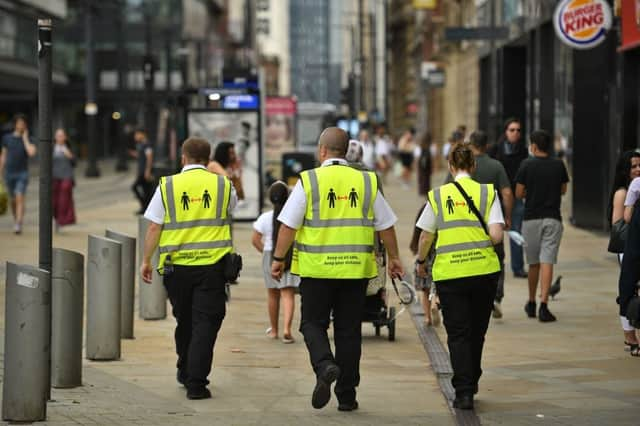These are the cities and towns that could be at risk of a local lockdown as coronavirus infection rates across England are revealed
This article contains affiliate links. We may earn a small commission on items purchased through this article, but that does not affect our editorial judgement.


Tougher lockdown restrictions have been enforced in parts of Northern England, following a recent spike of coronavirus cases in some areas.
The UK government announced the strict measures on 31 July, with the new rules affecting people who live in parts of Greater Manchester, East Lancashire and West Yorkshire.
Advertisement
Hide AdAdvertisement
Hide AdSimilar restrictions are already being enforced in Leicester as part of efforts to minimise the risk of any further spread of the virus.
But could other parts of the UK be at risk of a local lockdown? Here’s what you need to know.
Where have local lockdowns been enforced?
A local lockdown was enforced in Leicester in mid-June following a surge in coronavirus cases, which saw non-essential shops forced to close along with schools, except for vulnerable children and key workers.
All but essential travel to, from and within the city has also been discouraged and residents have been told to stay at home wherever possible.
Advertisement
Hide AdAdvertisement
Hide AdRestrictions for the Borough of Oadby and Wigston were lifted on 1 August, while businesses and venues can reopen in Leicester City from 3 August. All other restrictions remain in place, with the next review to take place by 13 August.
In parts of Greater Manchester, East Lancashire and West Yorkshire, people are no longer allowed to meet with people who do not live in their household in a private home or garden, or in other indoor public venues, such as pubs, restaurants, cafes, shops and places or worship.
Could more local lockdowns be imposed?
The government has not confirmed any further local lockdowns will be enforced, although tougher restrictions could be imposed in areas that see a surge in coronavirus infections, as has been the case in parts of Northern England.
Prime Minister Boris Johnson recently expressed concerns of a second wave of coronavirus following the spike in infections in Spain, warning the UK could see a similar situation develop within as little as two weeks.
Advertisement
Hide AdAdvertisement
Hide AdSpeaking during a visit to Nottingham on 28 July, Mr Johnson stressed that the most important thing is for people in all communities to “heed the advice” before restrictions can be eased across the country.
He said: “Clearly we now face, I’m afraid, the threat of a second wave in other parts of Europe and we just have to be vigilant and we have to be very mindful.”
The Prime Minister is also reportedly considering asking a greater number of people in England to take part in the shielding programme, should there be a spike in coronavirus cases.
This could see millions of people aged between 50 and 70 be told to stay at home in order to prevent a second nationwide lockdown.
Advertisement
Hide AdAdvertisement
Hide AdA Sunday Times report said that people in this age group could be given personalised risk ratings, taking into account factors such as age and medical conditions.
Which areas have the highest infection rate?
The towns and cities in England with the current highest rates of coronavirus infections have been named by Public Health England (PHE).
The updated list is based on figures from the seven days to 26 July, and on tests carried out in laboratories and in the wider community.
Blackburn with Darwen topped the list for the highest rate of coronavirus infections, with the rate rising from 81.2 cases per 100,000 people to 87.3. A total of 130 new cases have been recorded in the area.
Advertisement
Hide AdAdvertisement
Hide AdOldham in Greater Manchester, which has recently seen tough restrictions reintroduced after a spike in cases, has drawn level with Leicester, with both areas broadly recording the same rate.
Oldham has seen its rate rise from 18.7 to 56.4, with 133 new cases, while the rate in Leicester has fallen slightly from 73.2 to 56.3, with 200 new cases.
Elsewhere, Trafford, Manchester, Sandwell and Swindon all showed noticeable week-on-week increases, with a significant number of new cases recorded.
Here are the 15 areas of England that currently have the highest coronavirus infection rates, based on the latest PHE figures. The rate is expressed as the number of new cases per 100,000 people, and is compared with the rate from the previous seven days from 19 July.
- Blackburn with Darwen - 87.3 (up from 81.2)
- Oldham - 56.4 (up from 18.7)
- Leicester - 56.3 (down from 73.2)
- Bradford - 47.3 (up from 42.6)
- Trafford - 38.1 (up from 11.0)
- Rochdale - 35.0 (down from 47.7)
- Sandwell - 32.4 (up from 23.2)
- Hyndburn - 32.2 (down from 39.6)
- Pendle - 31.7 (up from 30.6)
- Eden - 30.3 (down from 32.1)
- Calderdale - 29.0 (up from 23.3)
- Melton - 27.4 (up from 7.8)
- Manchester - 23.2 (up from 14.2)
- Northampton - 21.3 (down from 28.0)
- Swindon - 21.2 (up from 8.1)